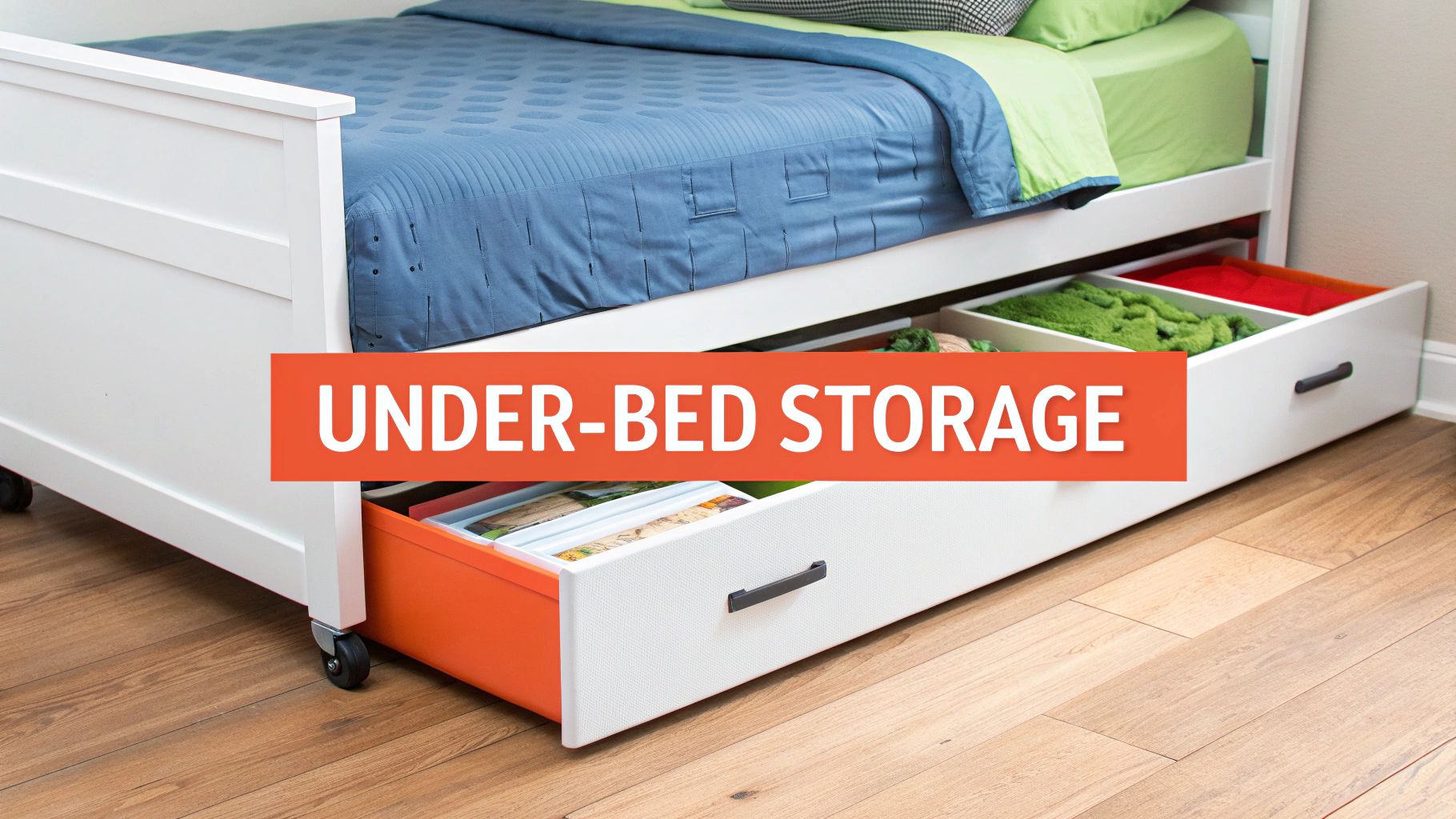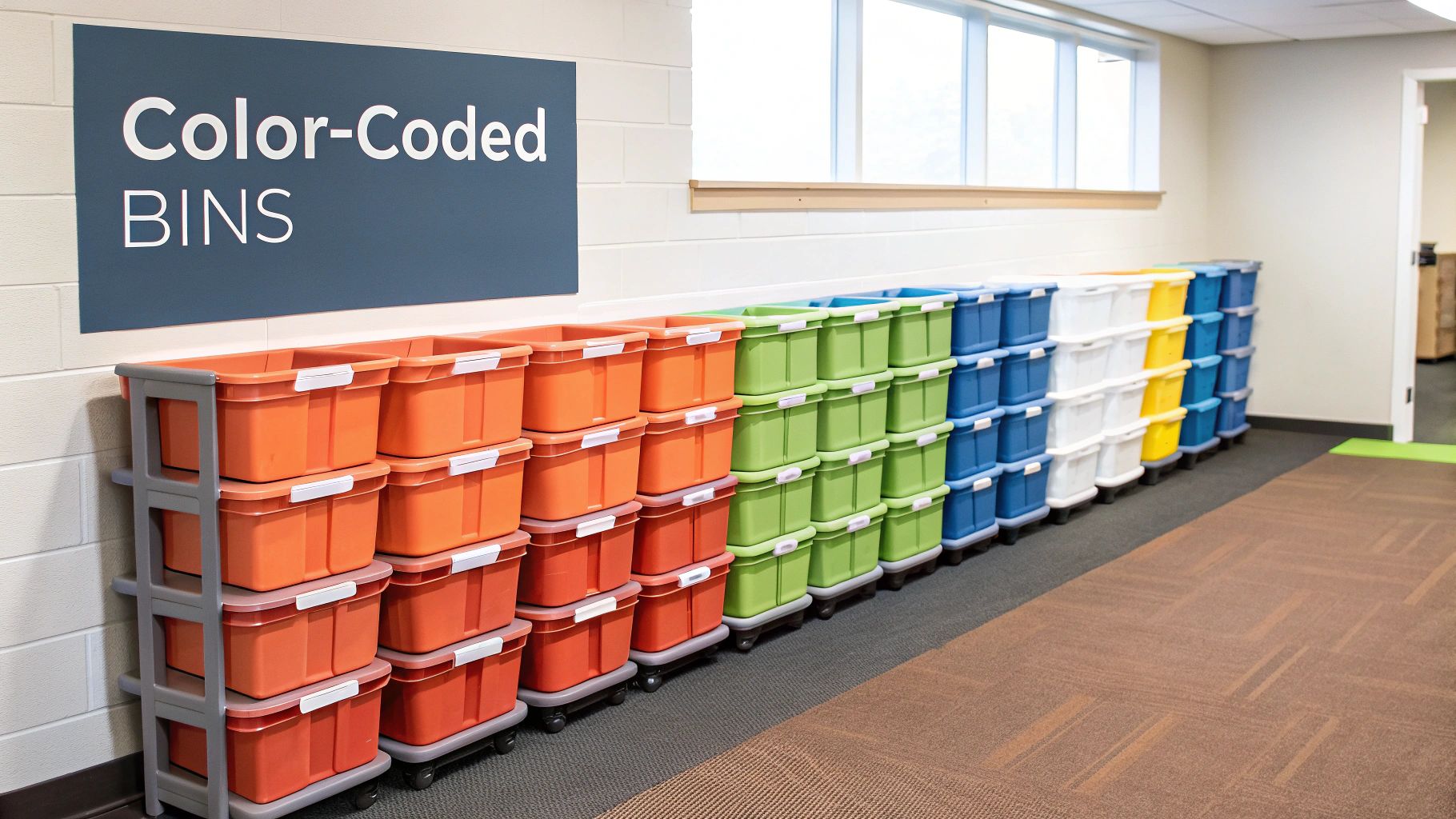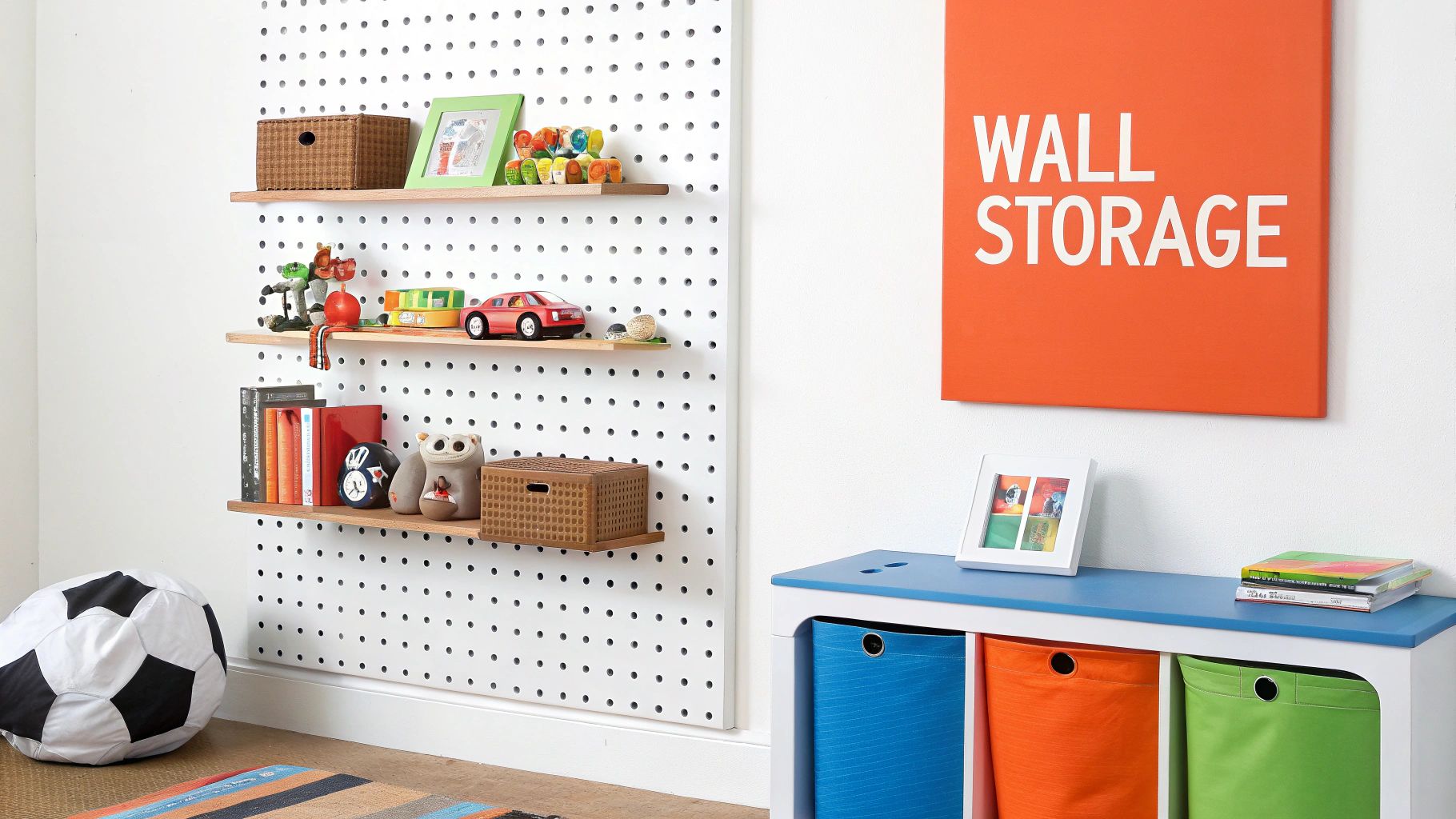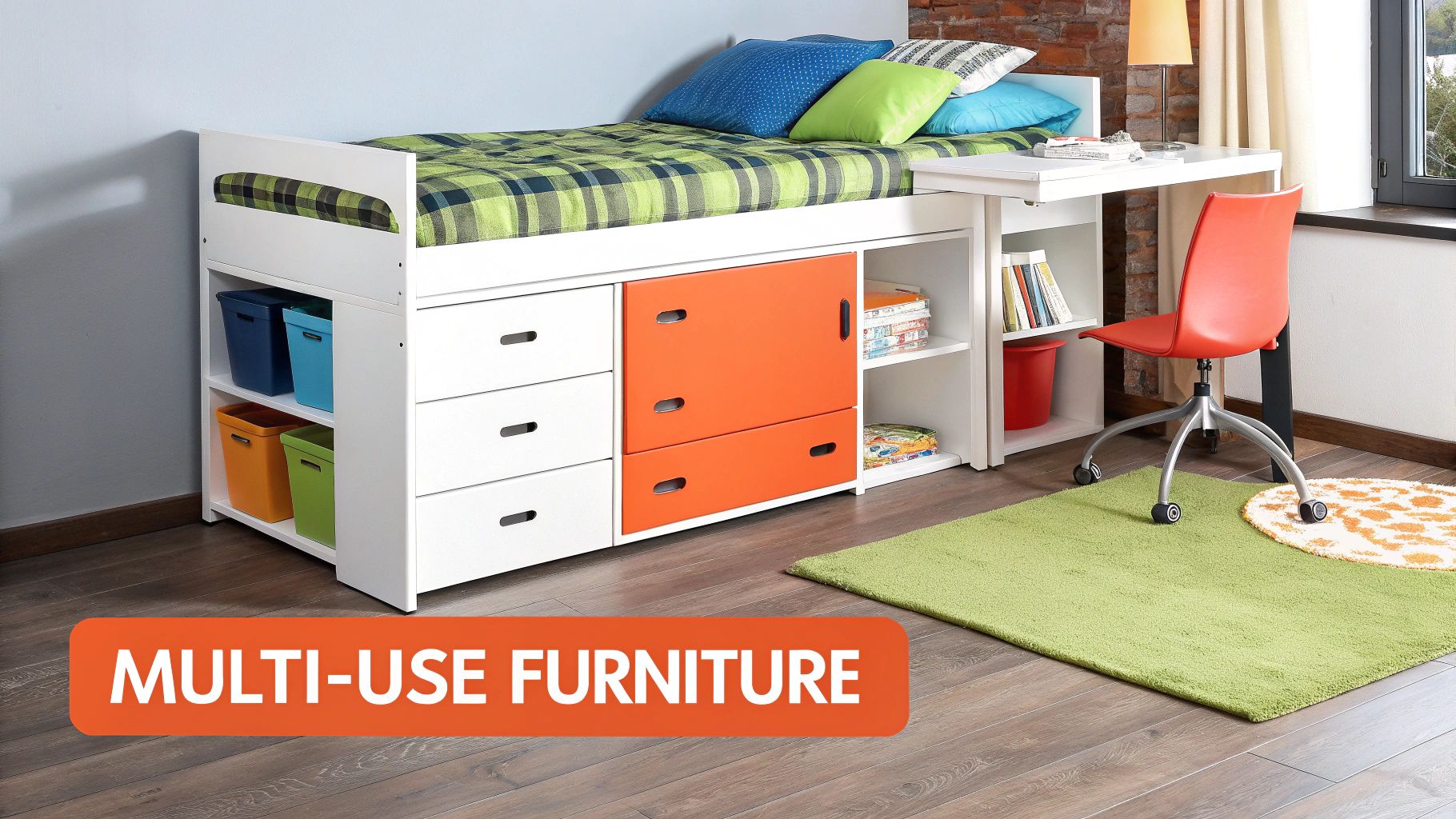-
CALL US:
- (866) 952-3456
A child's bedroom is more than just a place to sleep; it's a sanctuary for play, learning, and dreaming. Yet, for many parents, it can feel like a constant battleground against clutter. Toys spill out of bins, books pile up in corners, and a mountain of clothes seems to materialize overnight. Effective kids bedroom organization is not just about aesthetics; it's about creating a functional, peaceful environment that supports your child's development, fosters responsibility, and reduces daily stress for the whole family. A well-organized room empowers children, giving them the skills and confidence to manage their own space.
This guide moves beyond generic advice to offer nine powerful, actionable strategies to transform even the most chaotic room into a model of order. We'll explore innovative systems, multi-functional furniture, and habit-building routines that make organization a sustainable part of your family's life. For a broader selection of items relevant to setting up and organizing children's spaces, consider exploring various general products for kids and babies. Get ready to reclaim the calm and create a bedroom your child will love to live in and, most importantly, help keep tidy.
The space under a child's bed is often an overlooked goldmine for storage. An under-bed storage system transforms this dead zone into a functional, accessible area, making it a cornerstone of effective kids bedroom organization. This approach clears valuable floor space for play while keeping toys, clothes, and bedding neatly tucked away but still within easy reach for little hands.

This method is ideal for smaller rooms where every square foot counts or for any room needing to declutter visible surfaces. From sturdy rolling drawers that slide out smoothly on carpet to lightweight fabric bins with handles, the options can be tailored to your specific needs and budget.
To maximize the benefits of this system, consider these practical tips:
A color-coded organization system uses visual cues to help children intuitively understand where their belongings go. By assigning specific colors to different categories of items, this method simplifies cleanup time and empowers kids to maintain order independently, making it a powerful tool for effective kids bedroom organization. This approach leverages a child's natural ability to recognize colors long before they can read, transforming tidying up from a chore into a simple matching game.

This strategy is particularly effective for toddlers and pre-readers, but it scales easily for older children as well. It works beautifully in playrooms, closets, and on bookshelves, creating a visually appealing and harmonious environment. Whether you use colored bins, labels, or even designated "color zones" on shelves, the system reduces clutter and the constant question of "Where does this go?".
To successfully introduce this visual organization method, follow these practical steps:
When floor space is at a premium, looking up is the answer. Vertical wall storage solutions transform unused wall areas into dynamic, functional hubs for toys, books, and supplies. This strategy is a game-changer for effective kids bedroom organization, lifting clutter off the ground and creating a clean, open environment for play and rest. It keeps essential items visible and accessible while also doubling as a decorative feature.

This approach is perfect for rooms of any size, especially those with limited square footage. By using floating shelves, pegboards, and wall-mounted cubbies, you can design a custom system that grows with your child. Popularized by brands like IKEA and The Container Store, these modular systems offer endless configurations to suit your specific organizational needs and aesthetic.
To make the most of your wall space, follow these actionable tips:
Choosing multi-functional furniture is one of the smartest strategies for maintaining excellent kids bedroom organization. These clever pieces serve dual purposes, combining essential functions like sleeping, seating, or studying with integrated storage. This approach significantly maximizes utility in rooms where space is a precious commodity, reducing clutter and freeing up the floor for play.

This method is particularly effective for small or shared bedrooms, allowing you to get the most out of every square foot. When space is at a premium, considering furniture that serves multiple purposes can be a game-changer for organization. For instance, exploring options like beds with built-in desk and storage can consolidate two large furniture items into one compact footprint. Popular pieces include storage ottomans, benches with hidden compartments, and loft beds with desks underneath.
To integrate these pieces successfully, focus on selecting items that will grow with your child and fit seamlessly into your home:
A toy rotation system is a game-changing strategy for managing the seemingly endless tide of toys. This approach involves keeping a select number of toys available for play while storing the rest out of sight, then systematically swapping them out. This method is a cornerstone of effective kids bedroom organization as it reduces clutter, prevents overwhelm, and renews a child’s interest in their existing toys, making old favorites feel new again.
Popularized by Montessori educators and minimalist parenting advocates, this system is perfect for families feeling swamped by toy chaos. It encourages deeper, more focused play by presenting fewer choices at one time. By limiting what’s accessible, cleanup becomes faster and less daunting for both kids and parents, transforming a messy playroom into a calm, inviting space.
To get started with this highly effective organization method, follow these practical steps:
A child's closet can quickly devolve into a chaotic pile of clothes, shoes, and forgotten toys. A dedicated closet organization system introduces structure, transforming this space from a source of stress into a streamlined wardrobe. This is a fundamental aspect of kids bedroom organization, empowering children to get dressed independently and keep their belongings tidy.
This method is perfect for teaching lifelong organizational habits and is adaptable to any closet size. Custom solutions like California Closets or modular options from IKEA's PAX series allow you to create a setup tailored to your child's specific needs, from double hanging rods to integrated drawers and shelves.
To create a functional and kid-friendly closet, focus on accessibility and logic:
A visual labeling system is a powerful tool in any kids bedroom organization strategy, especially for pre-readers and early readers. By pairing clear images with simple text, this method empowers children to identify where their belongings go, fostering independence and making cleanup a manageable, even fun, task. It transforms abstract organizational concepts into a concrete, easy-to-follow game of matching.
This approach, popularized by Montessori educators, is perfect for organizing everything from toy bins and art supplies to clothing drawers. It reduces the constant "Mom, where does this go?" questions and helps instill lifelong habits of tidiness by making the system intuitive for the youngest members of the household.
To create an effective and lasting visual system, follow these practical steps:
Modular storage cubes are the chameleons of the furniture world, offering unparalleled flexibility that adapts as your child grows. This system uses individual, often stackable, cubes that can be arranged in countless configurations, making it a powerful tool for effective kids bedroom organization. Whether you need a low-slung bench for toddlers or a tall bookshelf for a teen, these cubes can be reconfigured to meet the moment.
This approach is perfect for rooms with awkward layouts, evolving storage needs, or for families who want a system that will last from the nursery to the college dorm. Popular examples like the IKEA KALLAX series or ClosetMaid Cubeicals provide a blank canvas that you can customize with bins, doors, or drawers to fit your specific organizational challenges.
To get the most out of this versatile system, follow these key strategies:
Even the most perfect storage system will fail without maintenance. Establishing daily organization routines is the secret to long-term success in kids bedroom organization. These structured habits teach children responsibility and transform tidying from a dreaded chore into a simple, automatic part of their day, creating skills that last a lifetime.
This approach is essential for any family looking to end the cycle of weekend-long cleaning marathons. By embedding small, consistent actions into morning and evening schedules, you prevent clutter from accumulating, making the room perpetually more manageable and peaceful for both parents and kids.
To successfully build these habits, focus on consistency and age-appropriate tasks:
| Item | Implementation Complexity 🔄 | Resource Requirements ⚡ | Expected Outcomes 📊 | Ideal Use Cases 💡 | Key Advantages ⭐ |
|---|---|---|---|---|---|
| Under-Bed Storage System | Moderate – requires fitting and cleaning under bed | Low – affordable materials or pre-made kits | Maximized floor space, reduced clutter | Bedrooms with limited floor space and kids needing easy access | Space maximization, dust protection, easy access |
| Color-Coded Organization | Moderate – initial setup and consistency needed | Low – color supplies and labeled bins | Improved independence, reduced decision fatigue | Young children, visual learners, families fostering autonomy | Visual clarity, encourages independence, adaptable |
| Vertical Wall Storage | High – installation on walls, mounting tools required | Moderate – shelving, pegboards, safety brackets | Floor space saved, visible organization | Small/shared rooms, maximizing vertical space | Saves floor space, decorative, grows with child |
| Multi-Functional Furniture | High – usually higher cost and needs careful selection | High – cost and quality durable furniture | Clutter reduction, space saving, multi-use functionality | Small bedrooms, budget-conscious, minimalist aesthetics | Dual-purpose, stylish, long-term usage |
| Toy Rotation System | Moderate – requires planning and ongoing management | Moderate – extra storage for inactive toys | Reduced overwhelm, sustained novelty | Families with many toys and kids easily overwhelmed | Reduces clutter, maintains toy interest, teaches appreciation |
| Closet Organization Systems | High – may need closet modifications and ongoing upkeep | Moderate to high – specialized organizers or renovation | Maximized closet space, easier dressing routines | Children gaining independence, families with extensive wardrobes | Professional look, protects clothing, promotes independence |
| Label and Picture System | Moderate – time-intensive labeling and upkeep | Low – printable labels or store-bought kits | Clear identification, supports all reading levels | Young children, visual learners | Inclusive labeling, customizable, promotes organization |
| Modular Storage Cubes | Moderate – requires assembly and space planning | Moderate – cost of modules and bins | Flexible, adaptable storage | Growing families, renters, flexible needs | Highly adaptable, affordable, easy reconfiguration |
| Daily Organization Routines | Low – requires consistency and habit-building | Minimal – charts or reminders | Lasting organization skills, reduced daily chaos | All families wanting long-term habits | Builds responsibility, improves harmony, sustainable |
Embarking on a quest for better kids bedroom organization is more than just a weekend project; it's a commitment to creating a more peaceful, functional, and nurturing environment for your child. Throughout this guide, we've explored a variety of powerful strategies, from clever under-bed storage systems and vertical wall solutions to the game-changing efficiency of a toy rotation schedule. By integrating these ideas, you’re not just clearing clutter, you’re building a framework for responsibility, focus, and creativity.
The journey from chaos to calm is built on a few core principles. Remember that the most successful systems are those that are not only implemented but also consistently maintained. The daily organization routines we discussed are the glue that holds everything together, transforming tidiness from a chore into a simple, ingrained habit. Likewise, using visual aids like color-coding and picture labels empowers even the youngest children to take ownership of their space, making cleanup an intuitive and manageable task.
To ensure your efforts last, focus on three critical pillars: Empowerment, Adaptability, and Consistency.
Empowerment: Involve your child in every step of the process. Let them help choose the color of the storage bins, decide where their favorite toys should live, and apply the labels. When they feel a sense of ownership over the system, they are far more likely to participate in maintaining it. This active involvement is the first step in teaching valuable life skills that extend far beyond a tidy room.
Adaptability: The perfect organization system for a toddler will not work for a ten-year-old. Your child's needs, interests, and abilities will constantly evolve, and your storage solutions must evolve with them. Modular storage cubes are fantastic for this, as they can be reconfigured as needs change. Be prepared to revisit and tweak your system every six to twelve months to ensure it still serves its purpose effectively.
Consistency: A one-time deep clean feels great, but the real magic happens with daily reinforcement. Make the "5-Minute Tidy" a non-negotiable part of the evening routine. This small, consistent effort prevents clutter from piling up and reinforces the organizational habits you're working to build.
By weaving these principles into the practical strategies we've covered, such as maximizing closet space and investing in multi-functional furniture, you create a powerful and sustainable solution. You are not just organizing a bedroom; you are laying a foundation for lifelong tidiness and teaching your child that their environment is something they can control and care for. This lesson in self-sufficiency and respect for their belongings is one of the most valuable gifts you can give them.
Ready to implement that new modular storage system or multi-functional bed but dread the thought of complex instructions and tiny parts? Let the professionals at Assembly Smart handle the setup for you. Their expert technicians will ensure your new furniture is built safely and correctly, so you can focus on the fun part: organizing your child’s brand-new space. Visit Assembly Smart to get a free quote and turn your organization plans into a stress-free reality.